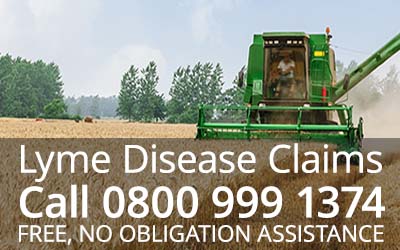
What Are The Symptoms of Lyme Disease?
The most common and well-know symptom of Lyme disease is a distinctive circular rash at the location where the tick bites and latches on to its human host, this is called Erythema Migrans (EM). The rash is often described as looking like the bullseye in the centre of a dartboard, although some prefer to liken it to the circular RAF logo used on military aeroplanes. The size of this rash can vary from quite small (1 or 2 inches across) up to large (8 -10 inches across) but typically has a diameter of around 6 inches (15cm). In most cases the rash does not hurt or itch, but it can be the only clear indicator of the infection. One of the challenges when diagnosing Lyme disease is that one in three people do not develop the rash, and so in many cases the disease is not suspected or treated accordingly.
Whether or not the sufferer develops the trade-mark rash, as the bacteria begins to spread through the body further symptoms are often displayed including:
- Chills and fever
- Sore throat
- Severe headaches and neck stiffness
- Nerve Pain
- Additional EM rashes on other parts of the body
- Intermittent pain in muscles, bones, joints and tendons
- Heart palpitations
- Arthritis of the larger joints such as knees, shoulders and hips
- Shortness of breath
- Dizziness
- Shooting pains in the hands and feet
- Numbness
- Tingling of the hands and feet
- Inflammation of the brain and spinal cord
Lyme disease is known to adversely affect the immune system which can lead to relapsing and remitting symptoms; ones that come and go without any real pattern of timings or pain, but commonly featuring fatigue as a side effect. As a result some of these symptoms can be confused with those of other conditions such as influenza, but also more serious condition such as Multiple Sclerosis, Motor Neurone disease, Meningitis, Encephalitis or other auto-immune conditions.
If you visit your GP with any of these symptoms it is critical that they perform appropriate medical tests but also question you about your activities – whether you spend or have spent time in ares where ticks are likely to reside, whether you work outdoors or in places that the risk of ticks is higher than normal, or if you have spent time abroad – some countries have far higher concentrations of ticks than the UK.
There are a variety of conflicting opinions and scientific uncertainty when it comes to the diagnosis of Lyme disease and research and development of methods and treatments are ongoing around the world.
Contact us today for free, no obligation advice regarding your Lyme Disease claim – either by calling us free on 0800 999 1374, or by requesting a free call back, whereby one of our team will contact you at a time of your choice, to discuss your situation.
We’re here to help – contact us today.

Claiming For Lyme Disease
Free Legal Advice
If you are unsure whether you can claim compensation for Lyme Disease, then call our personal injury claims team for free, no obligation advice on making a claim. They will ask you some simple questions about your condition, talk to you about what’s happened and can tell you if you have a viable claim for compensation or not. Call us free on 0800 999 1374.
Latest Lyme Disease News
Forestry Worker Claims £80,000 for Lyme Disease
A Scottish man who developed Lyme disease and became seriously ill has launched a legal claim for £80,000 against his employers for failing to do enough to protect workers from the potentially life-threatening disease.Iain MacEchern had worked for the Forestry...




